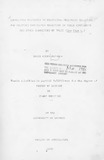| dc.description.abstract | Maize breeding work started at Kitale in 1955. A large collection of maize germplasm was introduced in 1959 from Central and South America. One of the varieties, Ec 573 performed well in a top cross yield trial with KSII. The cross of KSII and Ec 573 was released in 1964 as H611. The composite KCA is an open pollinated advanced generation of H611.
The aims of this study were to:
(1) Examine the response of KSII and Ec 573 to five cycles of reciprocal recurrent selection and KCA to ten cycles of modified ear-to-row selection.
C2) Compare the correlated changes in yield components of the four populations, and
(3) Identify important yield components for improving grain yield in a selection I programme.
During reciprocal recurrent selection in KSII and Ec 573 grain yield of their crosses, H611 was the only criterion for selection. Similarly yield was the only selection criterion during modified ear-to-row selection in KCA. However, selection for low ear placement, root lodging » ♦
ix- -
resistance, leaf blight' and rust" resistance was carried out in the nursery. Diseased ears were discarded.
The entries were from five cycles of reciprocal recurrent selection in KSII and Ec 573 and their six hybrids crosses, HB11 and five cycles of KCA.
Ec 573 did not have cycle zero. H614C and H622 were used as checks. These 25 entries were grown at locations N.A.R.S. - (Kitale), Sabwani and Elgon Rock in a randomized complete block design with six x-ep lications. Analysis using orthogonal polynomials was done.
Combined mean values of grain yield in KSII
varied from 43.8 q/ha to 53.0 q/ha and in Ec 573 it
varied between 43.1 q/ha to 49.9 q/ha. H611 showed
an increase of 5.41% (2.07 q/ha) per cycle of
selection. The combined mean grain yield of H611,
increased highly significantly from 67.7 q/ha in
(CO) to 86.0 q/ha in (C5). Open pollinated KCA
showed an increase of 5.38% (2.03 q/ha) per cycle
of selection. There was highly significant increase
in grain yield in KCA, which varied from 41.8 q/ha
in (CO) to 66.3 q/ha in (CIO). H611 and KCA showed
highly significant positive linear response.
» ♦
X
Most of the yield components in KSII and Ec 573 showed decline except the number of ears per 100 plants which showed an increase after five cycles of reciprocal recurrent selection. The decrease observed in yield components and some of the other characters affecting grain yield in KSII and Ec 573 was due to inbreeding depression, while increasing the frequency of favourable alleles. The H611 showed heterosis in most of the yield components, except number of rows per ear which was stable. Some hybrid vigour was also observed in some of the. other characters affecting grain yield. The hybrid vigour observed in all characters in H611 was due to exploitation of non-additive gene effects. Most of the yield components in KCA showed increase except 1000-kernel weight which decreased after ten cycles of modified ear-to-row selection. Most of the yield components and some of the other characters affecting grain yield in KCA showed increase because of utilizing • additive gene effects. Thus, H611 was more efficient in partitioning of assimilates whereby achieved higher grain yields than KCA.
Harvest index showed small increases in KSII and Ec 573 after five cycles of reciprocal recurrent selection., However, there were substantial
XI
increases in harvest -index in H&ll- and KCA.
For practical purposes the number of ears per 100 plants (i.e. number of ears per plant or prolificacy) and weight of kernels per ear were identified to be the most reliable components of grain yield, which could be used as effective criteria of selection. Also, harvest index though not a direct component of yield, could be considered as an important selection criterion in maize improvement programmes. | |

